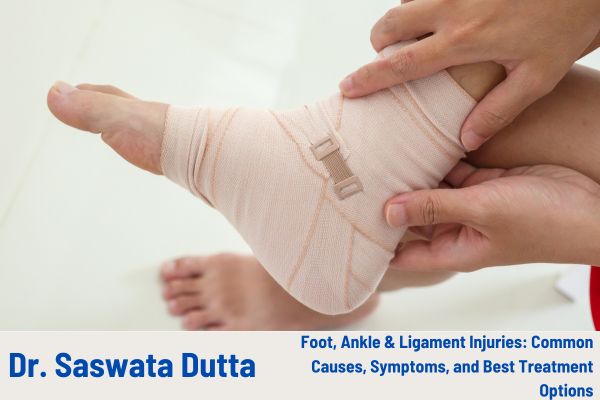Introduction
Foot and ankle injuries are among the most common orthopedic issues, affecting athletes, fitness enthusiasts, and even individuals in their daily routines. A sudden twist, an improper landing, or repetitive strain can lead to pain, swelling, and restricted movement. Dr. Saswata Datta provides expert insights into understanding these injuries, their symptoms, and the most effective treatment options.
Common Causes of Foot, Ankle & Ligament Injuries
- Sports and Physical Activities
- High-impact activities like running, basketball, and soccer increase the risk of sprains, fractures, and ligament tears.
- Improper Footwear
- Wearing unsupportive or ill-fitting shoes can put excessive strain on the foot and ankle.
- Accidents and Falls
- Slipping, tripping, or a misstep can cause fractures, ligament damage, or tendon injuries.
- Overuse and Repetitive Stress
- Runners, dancers, and individuals on their feet for long hours are prone to stress fractures and tendonitis.
- Medical Conditions
- Arthritis, osteoporosis, and flat feet can make the foot and ankle more susceptible to injuries.
Symptoms of Foot, Ankle & Ligament Injuries
- Pain and Tenderness – A dull ache or sharp pain in the affected area.
- Swelling and Bruising – Indicates inflammation and tissue damage.
- Limited Mobility – Difficulty walking or putting weight on the foot.
- Instability – Feeling of weakness or “giving way” in the ankle.
- Visible Deformity – In severe cases, a misalignment of the foot or ankle may be noticeable.
Best Treatment Options for Foot, Ankle & Ligament Injuries
1. Immediate First Aid (RICE Method)
- Rest: Avoid weight-bearing activities to prevent further damage.
- Ice: Apply ice packs for 15–20 minutes every few hours to reduce swelling.
- Compression: Use bandages or braces to provide support and limit swelling.
- Elevation: Keep the injured foot raised to reduce fluid buildup.
2. Non-Surgical Treatments
- Pain Management: Over-the-counter pain relievers like ibuprofen can help reduce pain and inflammation.
- Physical Therapy: Strengthening exercises and stretches to restore function.
- Bracing & Orthotics: Custom shoe inserts or ankle braces for additional support.
3. Surgical Treatments (For Severe Cases)
- Ligament Repair: Torn ligaments may require surgical intervention.
- Fracture Fixation: Severe fractures might need pins, plates, or screws for stability.
- Arthroscopy: A minimally invasive procedure to treat ligament or cartilage damage.
When to See Dr. Saswata Datta?
Consult a specialist if:
✔ The pain is persistent and severe.
✔ You cannot bear weight on the affected foot or ankle.
✔ There is visible deformity or excessive swelling.
✔ The injury does not improve with home remedies.
Preventing Foot & Ankle Injuries
Wear well-fitted, supportive footwear.
Warm up before exercise and cool down afterward.
Strengthen ankle and foot muscles through targeted exercises.
Be cautious on uneven surfaces.
Listen to your body and rest when needed.
Conclusion
Foot, ankle, and ligament injuries can be painful and disruptive, but timely treatment ensures a full recovery. Dr. Saswata Datta specializes in diagnosing and treating these injuries using advanced techniques. Whether through non-surgical treatments or surgery, expert care can help restore mobility and prevent long-term complications.
If you’re experiencing foot or ankle pain, schedule a consultation with Dr. Saswata Datta for a personalized treatment plan!
